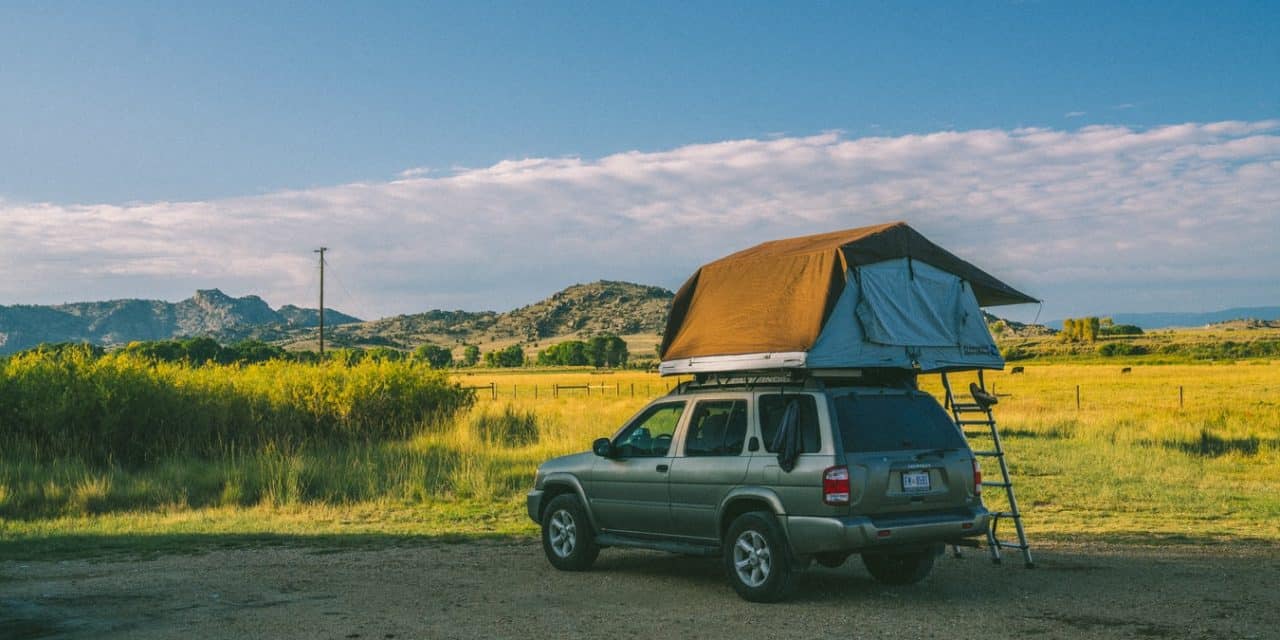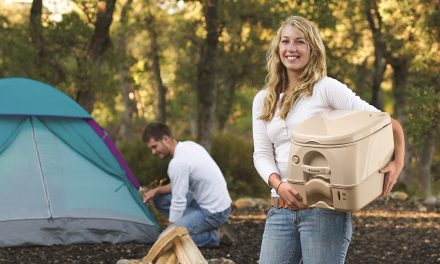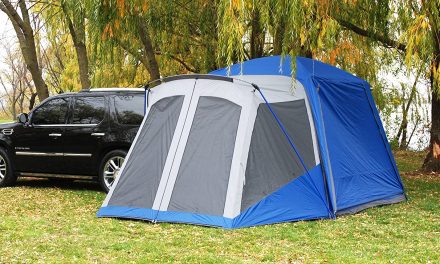Originally developed to protect campers from dangerous wildlife, snakes, and things that bite in the night, a roof top tent is now a popular accommodation choice for road trips. Roof top tents give you the freedom to set up camp anywhere you choose, from outback campgrounds to gas stations. What’s more, most only take a few minutes or less to set up.
As roof top tents become more common, you’ll find there’s a lot more available on the market. So how do you choose the best roof top tent for you? In this article, we’re going to answer that question. We’ll also suggest the top five rooftop tents for overlanding in 2021 and address any common questions you might have.
Best Rooftop Tents – Quick Summary
[#1] TOP PICK: |
| ||
[#2] BEST BUDGET PICK: |
| ||
[#3] BEST HARD SHELL: |
| ||
[#4] BEST FOR COUPLES: |
| ||
[#5] BEST FOR SMALL CARS: |
|
What are rooftop tents?
Rooftop tents are different from truck tents, which sit in the bed of a truck, and SUV tents, which connect to the back of an SUV, because they attach to a roof rack like a cargo box. Furthermore, most rooftop tents are either softshell or hardshell in design.
Unlike truck tents and SUV tents, you can fit rooftop tents to various vehicles, including trucks, SUVs, hatchbacks, and vans. Once installed on a roof rack, all you need to do when you arrive at your camping destination is unfold or pop-up the tent.
> Softshell Roof Top Tents
Softshell rooftop tents are the more popular choice. These are similar to a ground tent, with heavy-duty wall and roof fabric stretched over a pole structure. The tent floor is attached to a hard base/top cover that folds out, giving you a floor area that’s double the tent’s packed size.
Therefore, softshell rooftop tents offer more sleeping space than most hardshells and usually have a lower price tag. Although reasonably easy to set up, they’re not as quick to pitch as hardshells.
> Hardshell Roof Top Tents
Hardshell rooftop tents have a solid roof, usually plastic, aluminum, or fiberglass, with waterproof fabric walls which makes them heavier than softshells.
Instead of folding out, they pop-up like a box or one side opens on hinges like a clamshell. With either the clamshell or box design, the floorplan usually fits within your vehicle’s length and width, which is useful when you’re sleeping roadside.
Although more expensive, hardshells tend to have a longer lifespan and offer better weather protection. When closed, they also allow enough space to store a camping mattress and bedding inside.
Are rooftop tents worth it?
Considering the price and hassle of installing a rooftop tent, you might be wondering if they’re worthwhile.
Rooftop tents put a decent distance between you and wildlife. As they’re elevated, rooftop tents can also provide better weather protection, particularly in heavy showers and areas prone to flooding. Additionally, because rooftop tents are quick to set up, they can save you a lot of time and effort when traveling overland.
They also give you the option of sleeping in unconventional places like car parks, highway rest stops, or RV campgrounds. If these features appeal to you, then a rooftop tent is probably worth it.
#1 – Tuff Stuff Ranger

For its quality materials, spacious design, and mid-range price tag, the Tuff Stull Ranger roof top tent is our top pick. The tent’s main body offers a generous sleeping space for three people, but this model also comes with a detachable annexe included. You can use the extra ground space as a second bedroom or cooking area, or leave it at home when it’s not needed.
Another great feature is the fully covered entrance that lets you climb in and out and take your shoes off without letting in any rain.
For weather protection, the canopy is highly waterproof, breathable, and UV resistant polyester cotton fabric. You also have a 420D polyester/Oxford material rainfly and a waterproof cover for the packed tent while driving.
When it comes to installation, Tuff Stuff claims that it should take 1-2 hours to install with two people. The universal mounting brackets (included) should fit most roof racks and, once mounted, the tent takes just a few minutes to set up.
pros
- Waterproof materials
- Spacious design
- Affordable price
- Annexe included
cons
- Heavy (154 lbs)
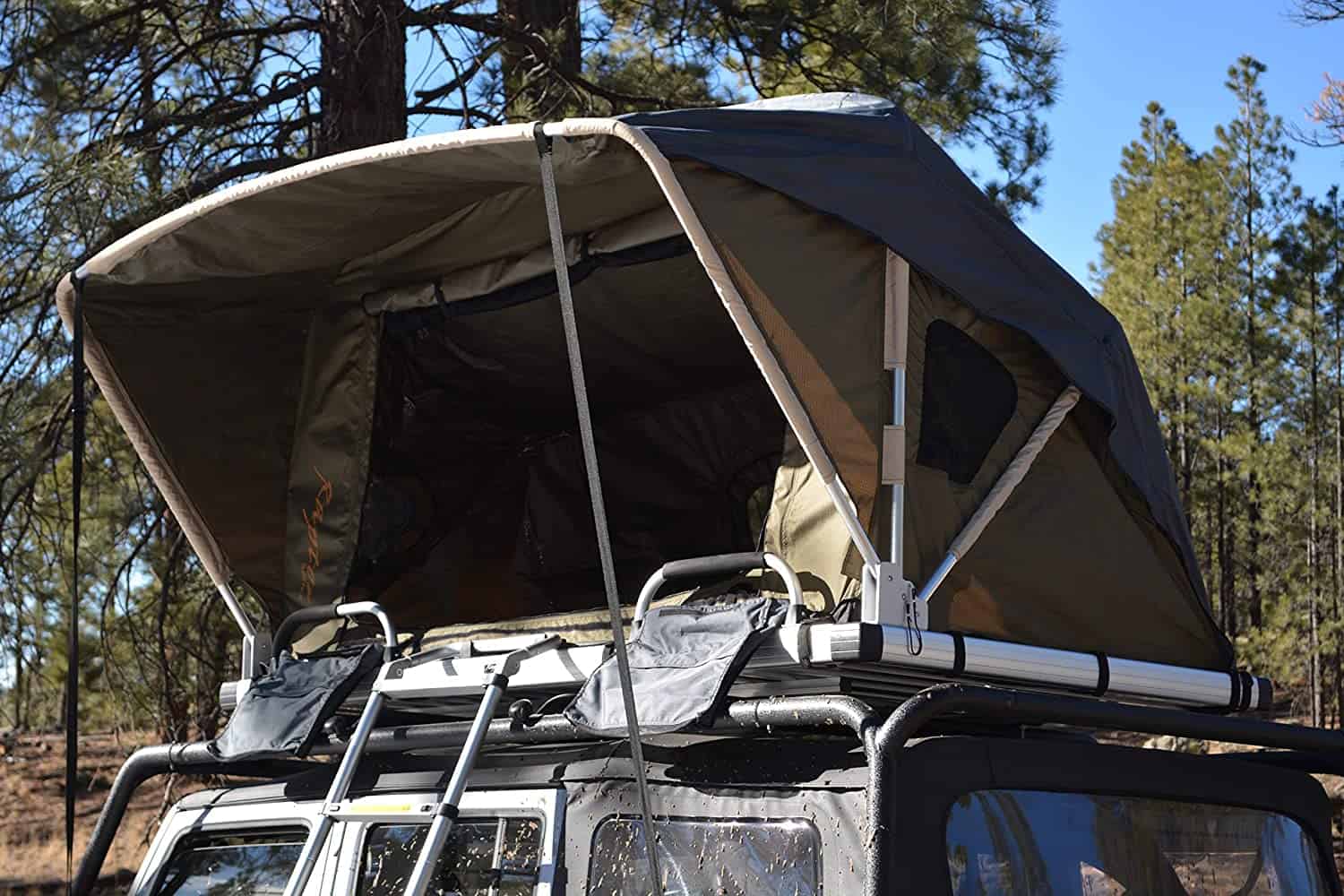

If you’re looking for a rooftop tent that won’t break your wallet, the OffGrid Voyager from Raptor Series might be your best option.
The design is different from other softshell tents because the base of the tent doesn’t fold out. Instead, you pull the canopy and frame into place using straps that clip under the car’s chassis. Therefore, the floor space is no wider than your roof.
It’s worth noting that, due to its size and weight, this rooftop tent is best for 4×4 vehicles or truck bed racks. Additionally, it’s only compatible with racks with a 160 lbs or higher weight capacity.
Its best feature is its built-in awning and full-wall zippered side-door, which gives you a panoramic view from your sleeping bag. This large door also has zippered bug mesh. Plus, there are windows on the front, back, and the opposite side, so you get plenty of daylight and good ventilation.
The downside of this design is that you’ll have to climb over your camping buddy to get out. For this reason, we recommend the OffGrid Voyager for solo travelers.
pros
- Huge entrance
- Simple setup
- Suitable for roadside camping
cons
- Not a good fit for small cars
- Less spacious than most two-person roof top tents
#3 – Roofnest Sparrow


The Rooftop Sparrow is one of the best hardshell rooftop tents on the market. Measuring at 85 x 50 inches, it fits almost any car with a roof rack.
On the inside, it’s spacious enough for two adults to sleep, even if you’re seven feet tall. There’s also plenty of headroom for sitting.
The most impressive feature is its fast setup and pack time. Just open a latch on each side and the tent pops up in seconds. A zipper gives you easy access to the marine-grade hinges in case they ever need repairing.
This tent has a reinforced fiberglass roof with tough polyester cotton canvas walls and a waterproof rating of 3000 mm. Wind, rain, and cooler temperatures shouldn’t be a problem for the Roofnest Sparrow. For warmer nights, all openings have both bug mesh and canvas covers that convert to awnings.
We also like that the latest version of the Roofnest Sparrow includes a solar panel mounting area and a built-in gear storage area with a waterproof bag (included). This model also comes with a 3-inch sleeping mat, an anti-condensation mat, and a telescopic ladder that can be mounted at any of the doors.
pros
- Fast setup
- Excellent weather protection
- Fits most vehicles
- Good inside storage
Super durable
cons
- Expensive
#4 – Yakima SkyRise HD 2


If you’re looking for a cozy retreat for two, the Yakima SkyRise HD 2 is our top choice. This four-season softshell tent has a durable aluminum frame and is sturdy and compact.
The main material is 600D ripstop polyester with a 3000mm waterproof coating and, to prepare you for the roughest weather, there’s also a 210D ripstop polyester rainfly.
Moreover, this is one of the simplest softshell tents to set up. The telescopic ladder is already attached to the base, so all you need to do is unzip and roll away the cover, open the ladder and push down. This action unfolds the base, pulling the tent body into place. Installation is easy too as Yakima has included tool-free and lockable vehicle mounts.
When it comes to usability, the SkyRise HD has larger doors and windows than most. All openings have zippered bug mesh and polyester covers.
One of the best design features is the roll-away roof windows on the tent and the plastic roof windows on the rainfly. These let you stargaze even in wet and snowy weather.
pros
- Takes a minute to set up
- Tool-free installation
- Large windows and doors
- Foam sleeping mattress included
- Compatible with an annexe
cons
- Mounting system may not fit all racks
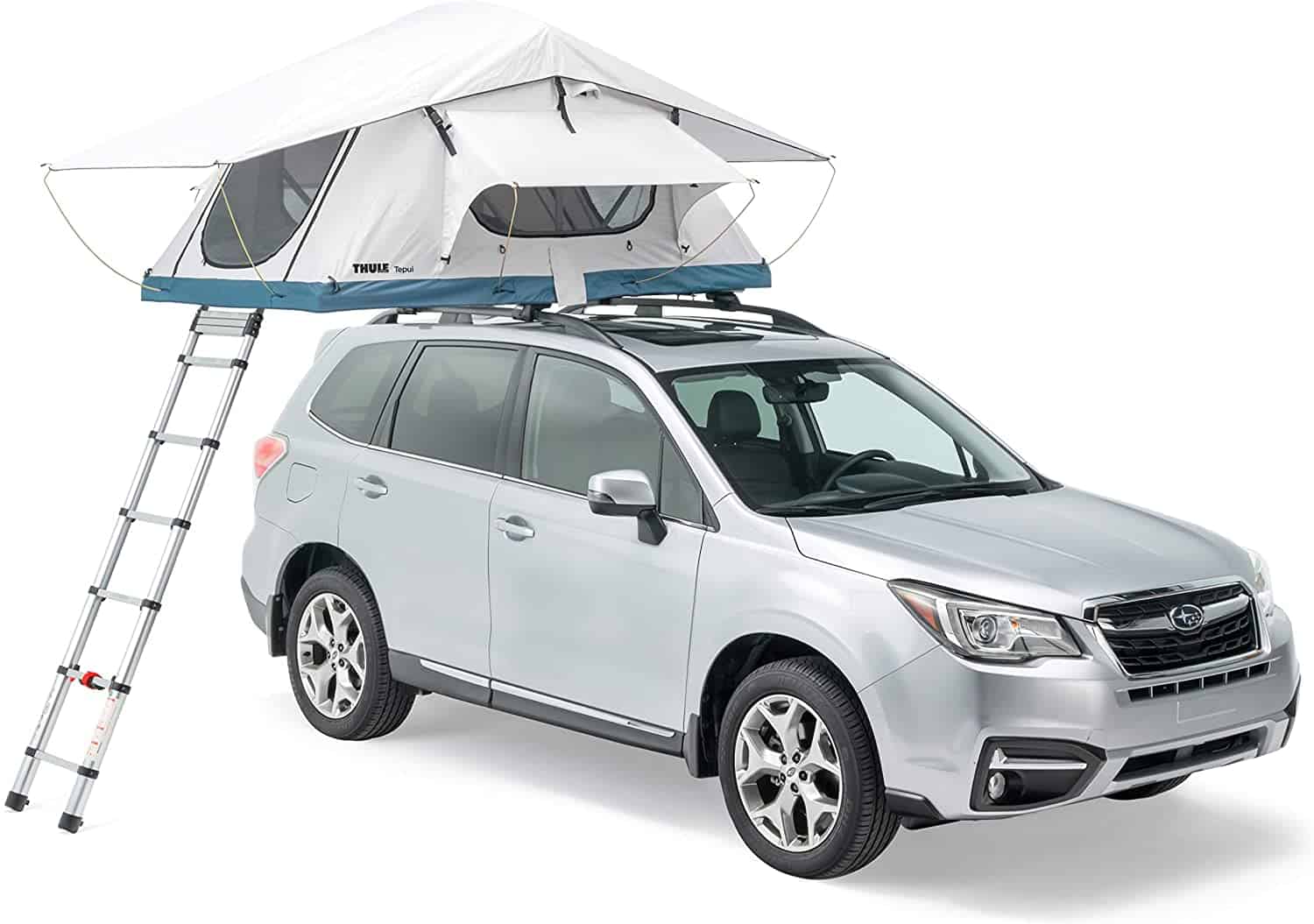
You don’t need to drive a truck or an SUV to use a rooftop tent. Instead, the Thule Tepui Low-Pro 2 is a practical choice for smaller vehicles. Its pack size is just 50 x 43 x 8.5 inches and the two-person version will fit a roof rack with a minimum railing distance of 25.2-inches.
Despite its low profile, the Tepui Low-Pro 2 is a durable four-season tent designed to withstand harsh weather conditions. Its UV resistant ripstop polyester canopy fabric and rainfly have a waterproof rating of 3000mm.
You can choose to open the doors and windows or use the bug mesh in the summer. Another bonus is that the tent base is constructed from super durable and 100% recyclable thermoplastic materials.
Just like the SkyRise HD, pushing down on the telescopic ladder will unfold the base and pull the dome-canopy into shape. In comparison, the Tepui Low-Pro 2 is less expensive, with a more compact packed size; however, the windows and doors are notably smaller.
pros
- Highly waterproof
- Compact pack size
- Suitable for small cars
- Contains recyclable materials
cons
- Small windows
What to look for when buying a rooftop tent
Compatibility
Not all rooftop tents are suitable for all types of car or roof rack. You’ll need to consider the following things:
- Packed dimensions of the tent. It shouldn’t overhang your vehicle when packed.
- Total weight of the tent. You’ll need to know this to work out if it’s suitable for your vehicle.
- Your vehicle’s static weight capacity. The maximum load your car’s roof can hold when stationary. It must be strong enough to hold the tent’s weight, sleeping equipment, and the number of people sleeping in the tent.
- Your vehicle and rack’s dynamic weight capacity. The maximum load your car’s roof can hold while moving. If your rack did not come with your vehicle, you would need to check the rack’s limit too. The limit should be higher than the packed tent’s weight, including any gear you will store inside while driving.
- Rack compatibility and mounting system. Check that your rack is compatible with the tent’s mounting system and that the distance between each rail is wide enough to accommodate the mounting brackets.
Ease of Setup
Whichever model you choose, make sure it’s quick and easy to set up. Look out for pop-up designs, hinged hardshells, or softshell tents with folding frames.
Durability
Rooftop tents are a lot more sturdy than backpacking tents. Most have a long lifespan, sturdy aluminium frames, or quality hinges. Hardshell tents with reinforced fibreglass roofs are even more durable than softshell.
Weatherproofing
Also, consider what climate you’ll be camping in. Highly waterproof fabrics are essential but you’ll want a breathable and UV resistant fabric for summertime. Likewise, large mesh windows and skylights are ideal for summer but less practical in cold weather.
Additional Features
For multi-day overland trips or larger groups, you might want a rooftop tent that’s compatible with an awning or annexe. Also, look out for gear storage pockets, shoe pockets or hanging gear nets. On overnight adventures, you might not want any extra space but a built-in mattress would be useful.
Frequently Asked Questions
ARE ROOF TOP TENTS SAFE FROM BEARS?
Roof top tents provide better bear protection than sleeping in a classic ground-based tent. That said, they are not 100% bear-proof as bears can climb. While camping in bear territory, you’ll still need to follow the usual precautions.
HOW MANY CAN SLEEP IN A ROOF TOP TENT?
That depends on the size of the roof top tent. The majority of roof top tents can sleep two to three adults. However, some are spacious enough for up to five people and you may be able to expand the sleeping space with an annexe attachment.
CAN YOU PUT A ROOF TOP TENT ON ANY CAR?
No, it also depends on the weight limit and dimensions of your car and roof rack. Some roof top tents are wider, longer, or heavier than others, so you can’t put any roof top tent on any car. See the compatability information above and always check the manufacturer’s guidelines.
HOW DO ROOF TOP TENTS STAY WARM?
Rooftop tents tend to be more insulated than regular tents but they can still get cold at night. A heavy sleeping bag and an old-fashioned hot water bottle can help you stay warm.
Alternatively, you can heat a rooftop tent with an electric or battery-powered tent heater. Out of the two, tent heaters with rechargeable batteries are more practical than electric heaters which will run down your car battery if left on overnight.
Let’s take a road trip
A roof top tent won’t suit everyone; they’re more expensive than regular tents, you may not have a suitable roof rack, or perhaps you don’t want to climb down a ladder every time you need the bathroom.
That said, roof top tents have many benefits, including protection from dangerous wildlife, flooding, and easy setup. The best roof top tent can be an excellent addition to an overland adventure.
- 5 Best Water Containers for Camping In 2021 - March 3, 2021
- 5 Best Rooftop Tents For The Outdoors In 2021 - February 5, 2021
- 10 Best US Campgrounds For People Who Don’t Camp - January 17, 2021

